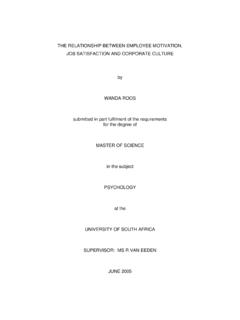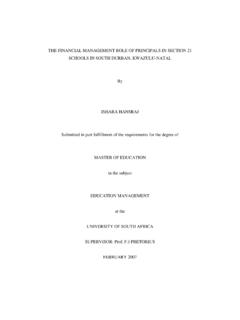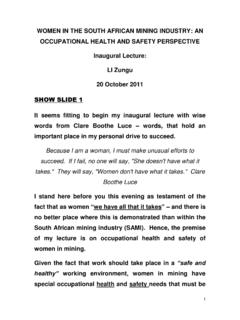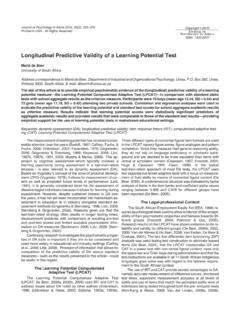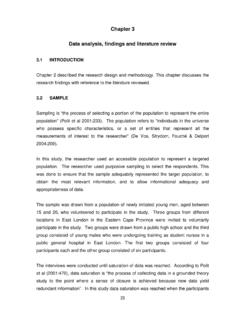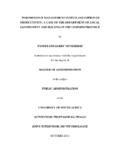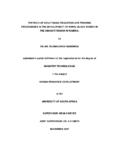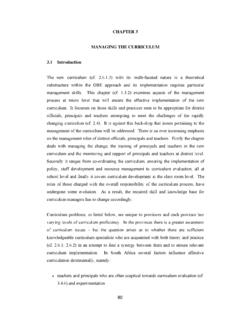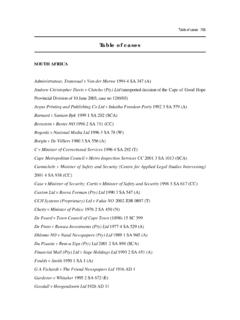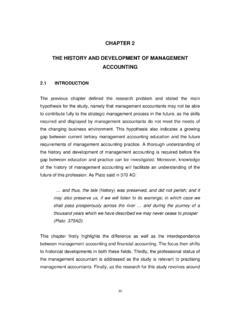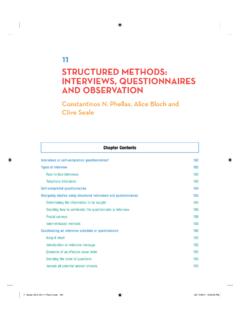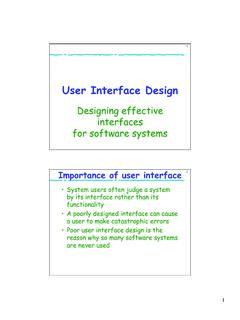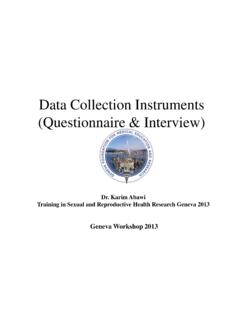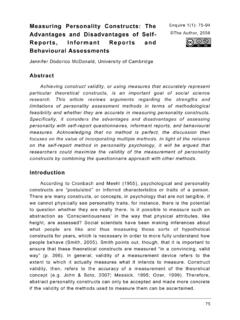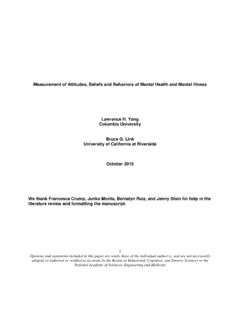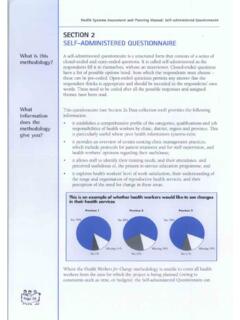Transcription of CHAPTER 3 Research methodology - Unisa
1 39 CHAPTER 3 Research this CHAPTER the Research methodology used in the study is described. The geographical area where thestudy was conducted, the study design and the population and sample are described. The instrument usedto collect the data, including methods implemented to maintain validity and reliability of the instrument, APPROACH AND DESIGNA quantitative approach was followed. Burns and Grove (1993:777) define quantitative Research as aformal, objective, systematic process to describe and test relationships and examine cause and effectinteractions among variables. Surveys may be used for descriptive, explanatory and exploratory descriptive survey design was used. A survey is used to collect original data for describing a populationtoo large to observe directly (Mouton 1996:232).
2 A survey obtains information from a sample of people bymeans of self-report, that is, the people respond to a series of questions posed by the investigator (Polit &Hungler 1993:148). In this study the information was collected through self-administered questionnairesdistributed personally to the subjects by the descriptive survey was selected because it provides an accurate portrayal or account of thecharacteristics, for example behaviour, opinions, abilities, beliefs, and knowledge of a particular individual,situation or group. This design was chosen to meet the objectives of the study, namely to determine theknowledge and views of patients and family members with regard to diabetes mellitus and its treatmentregimen (Burns & Grove 1993:29).
3 SETTINGThe study was conducted at Nkhensani Hospital and Giyani Health Centre which fall under the LowveldRegion, Mopani District in the Limpopo Province (RSA). The hospital has an average bed occupancy of253. It caters for the health needs of people who are referred to it from 20 clinics. The majority of the clientsare black. Giyani Health Centre has a bed occupancy of 10 and is km south-east of NkhensaniHospital. It refers its clients to STUDY POPULATION AND SAMPLEA ccording to Burns and Grove (1993:779), a population is defined as all elements (individuals, objects andevents) that meet the sample criteria for inclusion in a study. The study population consisted of all adultdiabetic patients and their living-in family members in the Mopani District who utilise the Nkhensani Hospitaland Giyani Health convenient sample of 64 subjects was selected from the two institutions.
4 Mouton (1996:132) defines asample as elements selected with the intention of finding out something about the total population fromwhich they are taken. A convenient sample consists of subjects included in the study because they happento be in the right place at the right time (Polit & Hungler 1993:176). The sample included 32 diabeticpatients and 32 family members. Available subjects were entered into the study until a sample size of 64was reached. Subjects who met the sample criteria were identified by the researcher at the Giyani HealthCentre and in the wards and outpatients department of the Nkhensani sample size of 32 patients and 32 family members were the total of subjects who were willing toparticipate in the Research and who met the sampling criteria during the six-month period of data sampling criteriaSubjects included in the sample were selected to meet specific criteria.
5 The diabetic patients had to meetthe following criteria to be included in the should: have had the disease for at least 5 years or more be mentally sound in order to consent to participation be willing to participate be 16 years or older obtain the consent of parents/guardians to participate if they are less than 18 years of age be of either sex or any raceThe family members of the diabetic patients had to meet the following criteria to be included in the should be: living with the diabetic patient41 mentally sound willing to participate 16 years or older of either sex or any Data collection instrumentA questionnaire was chosen as data collection instrument. A questionnaire is a printed self-report formdesigned to elicit information that can be obtained through the written responses of the subjects.
6 Theinformation obtained through a questionnaire is similar to that obtained by an interview, but the questionstend to have less depth (Burns & Grove 1993:368).Data was collected with the aid of questionnaires to evaluate the patients' and family members' knowledgeand views on diabetes mellitus. Questionnaires were decided upon because of the following: They ensured a high response rate as the questionnaires were distributed to respondents to completeand were collected personally by the researcher. They required less time and energy to administer. They offered the possibility of anonymity because subjects names were not required on the completedquestionnaires. There was less opportunity for bias as they were presented in a consistent manner. Most of the items in the questionnaires were closed, which made it easier to compare the responses toeach from the advantages that have been listed above, questionnaires have their weaknesses; forexample, there is the question of validity and accuracy (Burns & Grove 1993:368).
7 The subjects might notreflect their true opinions but might answer what they think will please the researcher, and valuableinformation may be lost as answers are usually questionnaires were used to collect the data. One was for the diabetic patients and the other one forfamily members or relatives of the patients. The questionnaires consisted mostly of closed-ended questionsand a few open-ended questions, as these provide more diverse detail. In the open-ended questions, thesubjects were required to respond in writing, whereas closed-ended questions had options which weredetermined by the researcher (Burns & Grove 1993:370). Open-ended questions were included because42they allow subjects to respond to questions in their own words and provide more detail.
8 Closed-endedquestions were included because they are easier to administer and to analyse. They are also more efficientin the sense that a respondent is able to complete more closed-ended items than open-ended items in agiven period of time (Polit & Hungler 1993:203).The questionnaires were in both English and Xitsonga to enable those who did not understand English tocomplete them in Xitsonga. For the two who could not read or write, the researcher read and wrote theiranswers for them. They were given the assurance that the answers would not be able to link theirresponses to them at the stage of data analysis, therefore ensuring anonymity. The questionnairesconsisted of sections A and B. Section A aimed at gaining demographic data such as age, level ofeducation, income and gender.
9 This information could assist the researcher when interpreting the results,for example, whether subjects lacked knowledge of diabetes mellitus because they were uneducated, orwhether they did not follow the prescribed treatment regimen due to lack of researcher collected all the information from the patients and family members. Section B aimed atdetermining the knowledge and views of patients and family members on diabetes mellitus and itstreatment regimen. Questions assessing knowledge about diet, medication, exercise, foot care andproblems experienced were included. Instruction guidelines were attached to the questionnaires to guidethe subjects as to whether to circle or tick the chosen collection procedureQuestionnaires were personally distributed by the researcher to patients and their family members tocomplete.
10 The researcher completed two questionnaires for those who couldn't read. The data wascollected over a period of six months. The researcher found some patients in the wards where they wereadmitted and their family members were found there during visiting times. Some of the patients were foundin the out-patients department together with their family members, and others at the health AND and Hungler (1993:445) refer to reliability as the degree of consistency with which an instrumentmeasures the attribute it is designed to measure. The two questionnaires which were answered by bothgroups, the diabetic patients and the family members, revealed consistency in responses. Reliability canalso be ensured by minimising sources of measurement error like data collector bias.
